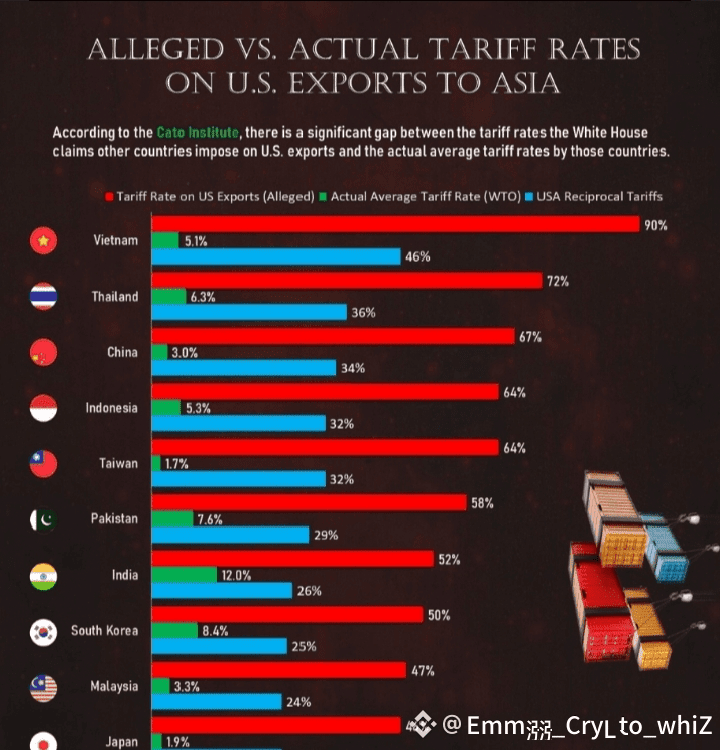📊 Alleged vs. Actual Tariff Rates on U.S. Exports to Asia
Country Alleged Tariff Rate Actual Avg. Tariff (WTO) Gap U.S. Reciprocal Tariff
🇨🇳 China 67% 3.0% 64.0% 34%
🇻🇳 Vietnam 90% 5.1% 84.9% 46%
🇹🇼 Taiwan 64% 1.7% 62.3% 32%
🇯🇵 Japan 46% 1.9% 44.1% 24%
🇰🇷 South Korea 50% 8.4% 41.6% 25%
🇮🇳 India 52% 12.0% 40.0% 26%
🇲🇾 Malaysia 47% 3.3% 43.7% 24%
🇮🇩 Indonesia 64% 5.3% 58.7% 32%
🇹🇭 Thailand 72% 6.3% 65.7% 36%
🇵🇰 Pakistan 58% 7.6% 50.4% 29%
---
⚖️ U.S. Trade Deficits Across Asia
The U.S. maintains deep trade ties across Asia — but also some of its largest trade deficits.
From China to Vietnam and Taiwan, America imports far more than it exports, and that imbalance is driving the push for reciprocal tariffs.
---
🇨🇳 China: The Biggest Deficit Partner
China remains America’s largest Asian trade partner — and the country with which the U.S. runs its largest global trade deficit, hitting roughly $295 billion in 2024 (U.S. Census Bureau).
While Washington claims Chinese tariffs on U.S. goods reach 67%, WTO figures show the actual average tariff is only 3%, according to the CATO Institute. The gap highlights major differences in how tariffs are perceived versus measured internationally.
---
🇻🇳 Vietnam: The New Manufacturing Powerhouse
Vietnam has become a key export and manufacturing hub, drawing global companies and creating strong trade flows with the U.S.
In 2024, the U.S. trade deficit with Vietnam reached $123 billion, making it the third-largest globally.
Despite U.S. claims of 90% tariffs, WTO-based data shows the real figure is just 5.1%, revealing a striking 85% difference.
---
🇹🇼 Taiwan: Tech Trade and Tariff Myths
Taiwan is central to U.S. trade in technology and semiconductors.
America recorded a $74 billion trade deficit with Taiwan in 2024.
However, while U.S. reports allege a 64% tariff, WTO data puts the actual rate at just 1.7%, suggesting the barriers are far lower than claimed.
---
🇯🇵 Japan: Trusted Ally, Trade Gap
Japan remains one of the U.S.’s most important trade allies in Asia.
The two nations recorded a $68 billion trade deficit in 2024.
According to U.S. claims, Japan imposes 46% tariffs on American exports — but WTO analysis shows the real average is just 1.9%, highlighting a major discrepancy in perception.
---
🇰🇷 South Korea: Low Tariffs, High Trade
Under the KORUS Free Trade Agreement, many barriers between the U.S. and South Korea have already been reduced.
Even so, America still reported a $66 billion trade deficit in 2024.
The U.S. alleges a 50% tariff on exports to Korea, but WTO data suggests the true rate is only 8.4% — one of the lowest among major Asian partners.
---
🌏 Other Key Asian Economies
Countries like India, Malaysia, Indonesia, Thailand, and Pakistan also play major roles in U.S. trade across Asia.
While Washington applies reciprocal tariffs on many of these nations, WTO data consistently shows lower actual tariff rates than those publicly claimed.
---
🧩 What the Numbers Reveal
When comparing alleged vs. actual tariffs, a clear pattern emerges — the U.S. often overestimates the barriers imposed by Asian economies.
According to WTO data and the CATO Institute’s analysis, nations such as China, Vietnam, Taiwan, and Japan actually maintain moderate to low tariffs on American goods.
Despite that, the U.S. continues to experience large trade deficits, suggesting the issue may lie more in production costs, supply chains, and competitiveness than in tariff walls.
---
💬 In Summary
The gap between claimed and actual tariff rates highlights how complex modern trade relations really are.
While tariff policies are often cited as a major obstacle, the data tells a different story — most Asian markets are relatively open to U.S. exports.
The real challenge for America may not be tariffs at all, but global trade dynamics, demand patterns, and cost advantages across Asia’s fast-growing economies.